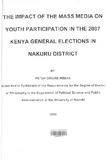| dc.description.abstract | Scholars have studied the effects of media exposure on political behavior since the 1940s. The results of these studies are mixed and inconclusive. This study examined the gross impact of mass media exposure on various forms of political participation by the youth aged between 18 years and 30 years during the 2007 Kenya general election campaigns in Nakuru .. District. The major
research questions addressed were: What was the impact of mass media exposure on youth participation during the 2007 general election campaigns in Nakuru District? What were the patterns of mass media exposure among the youth during the 2007 general elections in Nakuru District? What were the associations between exposure to various types of mass media and forms of
youth political participation during the 2007 general elections in Nakuru District?
The hypotheses were: One, the higher the exposure of the youth to mass media during the election campaigns the higher the level of political participation during the election campaigns. Two, socioeconomic status of youth is a major determinant of mass media exposure during election campaigns. Three, there is a significant association between various types of mass media and forms of youth political participation during election campaigns. The study used an eclectic approach to develop the conceptual framework because no single theory in literature could explain the relationship between mass media exposure and youth political participation during election campaigns. It involved the synthesis of three theories namely: civic voluntarism, political mobilization and uses and gratifications theories.
The civic voluntarism theory was used to identify and describe the interplay of the various determinants of youth political participation. The uses and gratifications theory elucidated patterns of and motivations for youth exposure to mass media. The political mobilization theory, on the other hand, gave explanation for possible effects of media on youth political participation. This study utilized cluster and systematic sampling techniques to collect primary data during two surveys. The first survey was conducted during the campaigns, a month before 2007 elections, and the second survey was done two days after elections for 10 days. Using the Nakuru District Survey Sample Register of 1999, trained researchers successfully interviewed 868 youth from 954 households in eight clusters in the district. Bivariate and multivariate logistic· regression analyses, using defined indices, were utilized to establish the impact of mass media exposure on youth political participation.
A key finding was that mass media exposure had a significant impact on youth participation during the 2007 Kenya general election campaigns in Nakuru District. A high level exposure to mass media increased the likelihood of youth political participation during the election campaigns. Surveyed youth scoring high on media exposure were nearly 6 times more likely to participate in election campaigns compared to surveyed youths not exposed to mass media during similar period. Television was the most preferred media for obtaining news during the election campaigns (55.6 percent) followed by radio (30.5 percent), newspapers (5.1 percent), mobile phones (1.4 percent) and internet (1.2 percent). Finally, there was a strong association between exposure to types of media and forms of youth political participation. Exposure to TV was strongly associated with talking politics (P<0.01); attending political rallies (P<0.01), doing general political work and working as security (P<0.01) for politicians and political parties during the 2007 election campaigns.
The study makes three conclusions. One, mass media were significant political mobilization agents of the youth during the 2007 election campaigns in Nakuru District. Two, some types of mass media (TV and radio) led to increases in youth political participation in the district. Three, two socioeconomic status variables namely gender and location of residence determined the impact of mass media exposure on youth political participation in Nakuru District. | en_US |

